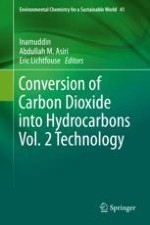Abstract
This chapter is dedicated to methanol synthesis from carbon dioxide and hydrogen. Methanol, chemical formula CH3OH, is an important platform molecule which can be transformed into a large number of other chemicals, i.e., formaldehyde, acetic acid, dimethyl ether, methyl tert-butyl ether, and methyl methacrylate, as well as complex hydrocarbon mixtures, e.g., gasoline and diesel. Up to date, methanol is produced at industrial scale by steam reforming of natural gas, leading to high environmental impacts. The selective hydrogenation of carbon dioxide into methanol can be a good alternative since it is possible to capture carbon dioxide from industrial processes and to produce hydrogen from renewable energies, e.g., solar energy and wind energy.
From a thermodynamic point of view, carbon dioxide hydrogenation is strongly influenced by the total pressure, temperature, and feeding composition. The use of a catalyst is also mandatory to control the kinetic and the selectivity into methanol. Among solid catalysts studied, copper-based catalysts have been found to be the best catalytic systems. Promoters like zinc oxide were usually used. Nickel-, palladium-, and silver-based catalysts also showed good catalytic performance compared to copper-based catalysts. Soluble catalysts have been intensively studied for this hydrogenation. Ru complexes appeared as the best homogeneous catalyst. Other metal-free homogeneous catalysts, e.g., N-heterocyclic carbenes, have been found to be active and selective in this reaction. Efforts have been made on the mechanistic study of the reaction in both the gas and liquid phases. Large industrial production has started in several countries showing the interest and the feasibility of the process.
